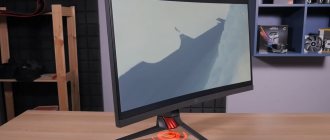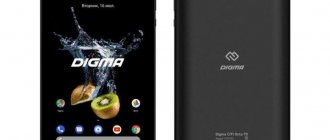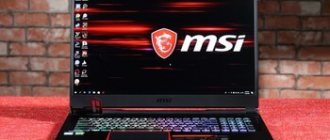Diagonal and screen resolution
At first glance, it seems that the choice is limited by budget and the amount of free space on the table. However, it is worth remembering that the higher the resolution, the greater the load on the video card. One chip will produce a different number of frames per second at Full HD and at QHD. The most popular resolution is 1920x1080 - this is the minimum for modern gaming. Less makes sense only in laptops with a small diagonal. As for sizes, there are many of them: from small 23-inch models to giants like the Samsung C49HG90DMI, which can easily replace two screens.
The best option is a diagonal of 27-32 inches with an aspect ratio of 16:9. Most games are developed based on this format: they will take up the entire screen, without leaving black bars around the edges, and there will be no need for image scaling. If you're going to be playing in 4K, a large 31-40 inch TV-like monitor will work well. However, note that Windows still doesn't adapt well to high resolutions (icons and text become too small), and some games not designed for 4K are severely distorted. The zoom functions do not always help.
Please note that there is no point in high resolution if the diagonal is small. In this case, you will not see all the benefits of high detail. This rule also works in the opposite direction. There is no point in buying a monitor with a large diagonal and low resolution. For example, Full HD doesn’t look the best on a 27-inch screen: many users complain about high graininess, due to the fact that every pixel can be seen with the naked eye.
There is also a format of curved monitors: they differ from flat ones in their smaller viewing angle and body shape. Such a device is worth buying only for gaming - playing behind a curved display while sitting directly in front of it is quite comfortable, due to the fact that the extreme points of the screen are closer to the eye than in the case of a flat monitor. But watching movies, especially in a group, will be inconvenient: half of the picture is not visible from the side of such a screen.
Screen resolution and its impact on FPS
Many people think that screen diagonal and resolution are about the same thing. This is wrong. Theoretically, you can make a small 20-inch monitor with a 4K resolution, but this simply makes no sense: the pixels will simply mix together and the high resolution will not be able to reveal its potential.
The “bigger is better” principle doesn’t work well here, because screen resolution is practically the only monitor characteristic that affects gaming performance: when the computer “renders” a picture, it must process every pixel of the monitor. The higher the resolution, the more pixels.
As a result, if you have a weak PC, then when moving from 1920x1080 to 4K, the number of frames per second can decrease by about 30-40%. Thus, for comfortable gaming in 4K resolution, you need a video card of at least GTX 1080 Ti or RTX 2080, and if you need to achieve a good frame rate of 1440p (2560x1440 resolution), then you can get by with a GTX 1070 level card.
However, switching to 4K has its advantages. Firstly, more and more modern video cards are created with an emphasis on high resolutions, which means that the drop in performance will be felt less and less over the years. Also, due to the higher resolution, you can refuse software anti-aliasing, but only if the monitor diagonal is between 24-27 inches.
Many manufacturers understand this. Models 24 and 27 inches (Full HD resolution) are perfect for medium-sized computers.
In addition to Full HD, MSI also has QHD solutions - for diagonals larger than 24 inches this is ideal, since the picture is clear, the fonts are perfectly readable, but the load on the video card is not as heavy as that of 4K monitors.
Brightness, contrast and matrix coverage
Choose a model with a brightness of at least 250 cd/m2. During the game you will be close to the monitor and, if necessary, you can reduce it. However, in a room with bright or natural light, high brightness will keep the image on the screen clearly readable. The contrast must be at least 1000:1, otherwise the image will not look sharp enough. We also advise you to pay special attention to the presence of modes to protect your eyesight: they will come in handy during a long game.
The screen coating can be glossy or matte. It is believed that gloss makes the picture “juicier”, but it does reflect a lot. The matte coating will not reflect, but will not embellish the picture. If you play in the evenings and there are no bright light sources or glare in your room, feel free to choose a glossy monitor. If there is always something shining into your screen, it is better to choose a panel with a matte finish.
Gaming monitor matrix type
By and large there are three options: TN, VA and IPS. TN matrices are characterized by low response time and low price: budget models mostly contain TN panels. However, this type has lower contrast (compared to IPS) and smaller viewing angles. VA is an average matrix in terms of characteristics, which is between TN and IPS. In terms of price, it is also in the middle segment. IPS monitors are a little more expensive and not as fast as TN ones. But they have better color rendition and wider viewing angles. For an IPS panel with a response time of 1 ms you will have to pay at least 3,000 more than for a similar model with a TN matrix.
If you play online games and the frame rate counter comes first for you, and the picture quality does not matter at all, feel free to take TN. If you prefer mostly single projects with rich graphics, then take a closer look at VA or IPS.
Frame Rate (Hz)
The frame rate is measured in Hertz and represents the number of frames a monitor can display in one second. The minimum for gaming is 60 Hz, but this value is only suitable for single games. In online battles, where there are many dynamic scenes, the smoothness of the picture is much more important. Therefore, it is better to choose 120, 144 or even 240 Hz displays.
At the moment, 240 Hz is the highest frequency that can be found on the market. Devices with this indicator are much more expensive than their slower counterparts. The cheapest 240 Hz monitor costs 20,000 rubles - this is the Acer KG251QDbmiipx with a diagonal of 27 inches and Full HD resolution. Monitors with 144 Hz are especially popular: the choice in this segment is much greater than among models with support for 240 Hz, you can even find devices with a diagonal of up to 49 inches.
Standard monitor sizes for gaming
When it comes to modern desktop monitors, most are in the 21 to 27-inch range. Anything smaller is now usually reserved for laptops or monitors that trade in size with other features like touchscreens, while monitors larger than 27 inches mostly have resolutions above 1080p.
Diagonals of 21-24 inches are reserved for 1080p monitors. This is also the best size range for 1080p, as anything larger will result in easily visible pixels when viewed close to the monitor.
Diagonals from 24 to 27 inches shine in 2K and, more precisely, in QHD and UHD resolutions. Both of them look incredibly sharp on these large screens, which provide some remarkable levels of detail. Needless to say, cramming all those pixels into anything less would be a waste of time.
G-Sync/FreeSync support
Video card manufacturers have developed adaptive synchronization technologies, with the support of which the monitor provides the smoothest picture possible. NVIDIA has G-Sync, and AMD has FreeSync. Models with G-Sync are more expensive, but they work with popular gaming video cards from NVIDIA.
On paper, the benefits of adaptive synchronization are obvious, but gamers are still arguing whether it makes sense in practice. We recommend choosing a monitor that supports G-Sync/FreeSync to eliminate image tearing and other visual defects using these technologies. In addition, hardware and video card drivers are regularly updated, which means frame synchronization technologies will also improve.
PROMISING NEW PRODUCT
Predator XB3 (XB273UGS)
This promising new product from Acer stands out in several ways. Firstly, the IPS monitor has a high Q HD (2560 x 1440). Secondly, the excellent scan speed is 120 Hz . And thirdly, low response time ( 1 ms ). This is already quite enough for comfortable gaming, but there are other features.
The panel supports NVIDIA G-Sync , and the screen uses DisplayHDR - these features help avoid image tearing and ensure maximum color accuracy. The new product will be available in Moscow in May.
Cost : from 48,990 rubles
Connection
Modern video cards use HDMI, DVI, DisplayPort and Mini DisplayPort connectors. VGA is already rare. To transmit 4K 30 fps, you will need support for HDMI 1.4, for 4K 60 fps - HDMI 2a or Displayport 1.3/1.4.
- Technologies
What is HDMI? Comparing cable types
Also, many gaming monitors are equipped with built-in speakers, a headphone jack, USB-A and USB-C ports, which allow you to connect peripherals or charge your smartphone. Additional functionality should be selected as needed. However, we note that the built-in speakers in the vast majority of cases will not have the best sound.
Smart lighting
The presence of backlighting and special programs for setting it up is quite commonplace. Most gaming mice and keyboards have long been produced with built-in LEDs, but there are still not very many monitors with them. Why is it needed? Well, for example, the backlight can signal the character’s health level or the amount of ammunition.
Many devices have long been produced with programmable backlighting, and this is cool especially for those who like to play. MSI currently has two backlit monitors - Optix MPG27CQ and Optix MPG27C. Each has five LEDs, which can be configured using the “software” that comes with the monitor itself - SteelSeries GameSense technology allows you to display game information when running supported titles.
Overall: what a good gaming monitor should be like
A properly selected gaming monitor will have the following characteristics: a diagonal of at least 27 inches with an aspect ratio of 16:9, a response time of 1-5 ms, a frame refresh rate of 60 Hz, support for G-Sync/FreeSync and the presence of HDMI and DisplayPort interfaces for connecting modern video cards All other parameters (for example, the appearance of the device and additional connectors) depend on your taste and budget. So that you don’t have to choose for a long time, we have compiled a small top monitors.
What about ultra-wide displays?
Most monitors have an aspect ratio of 16:9. While it's not hard to find a monitor with a 16:10 ratio, for this article we'll assume a standard monitor is 16:9. However, there is a growing interest in the market for 21:9 monitors, known as “ultrawide”.
Ultrawide monitors can be great for gaming. If you take one with high resolution and the game supports it, then the pleasure will be indescribable.
However, many modern FPS games do not support a horizontal field of view wider than 90 degrees. This is fine on a 16:9 monitor, but on an ultra-wide monitor it can result in image stretching or distortion. If you play competitively or prefer FPS, then you probably won't want to use an ultra-wide display.
Multiple display setup?
Multi-display setups are another can of worms. There's no consensus on what screen size you need, how many screens you should have, what configuration you should run them in...
But, games with them can be quite good, especially if you run them in a 1x3 or 3x3 configuration. They offer the same level of immersion as an ultrawide display, but... here we get the same problems as with an ultrawide monitor.
The best gaming monitors of 2021: model ratings
Iiyama G-Master G2730HSU-1
The gaming monitor from Iiyama meets all our requirements: it is a 27-inch diagonal TN panel, decent resolution (1920x1080 pixels), FreeSync support and a low response time of 1 ms. HDMI, DisplayPort and even VGA connectors are used to connect to a computer. Plus, there are speakers and a USB hub. Moreover, the model costs only 13,000 rubles.
HP OMEN 27
An almost frameless gaming monitor from HP based on a TN matrix with a 2K resolution is suitable for shooters and racing. The 165Hz frequency, 1ms response time and G-Sync support promise smooth images even in fast-paced gaming scenes.
AOC G2590FX
If you are looking for a small gaming monitor, pay attention to the model from the popular manufacturer AOC. The 24.5-inch matrix looks very unusual: it has almost no frames. The resolution matches the screen size - Full HD. Other characteristics are at the level of top models: 1 ms, 144 Hz, FreeSync support.
MSI Optix AG32CQ
The curved monitor with a diagonal of 31.5 inches is distinguished by an unusual type of matrix for a gaming device - VA, which provides a response time of 1 ms and good color rendition. There's also FreeSync support and a high refresh rate of 144Hz.
Xiaomi Redmi Display 1A
As a budget solution for an inexperienced gamer, products from the affordable Xiaomi brand are suitable. It cannot be said that this model stands out from the rest in any way (except perhaps for its low price), but it is equipped with the most minimal set of necessary characteristics. Polling rate - 60 Hz, brightness - 250 cd/m², matrix - IPS.
Xiaomi Mi Surface Display
But you shouldn’t associate the Chinese corporation only with budget devices. Here is a model for 34,000 rubles, which has excellent characteristics and offers gamers 4K resolution, a high contrast ratio of 3000:1 and a refresh rate of 144 Hz. Almost all reviews of the model are extremely positive.










